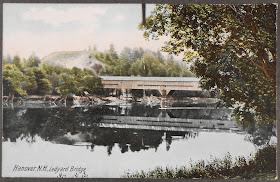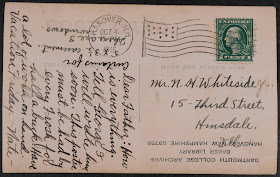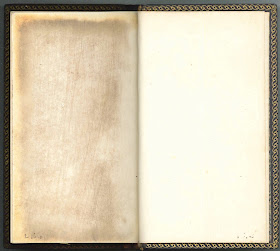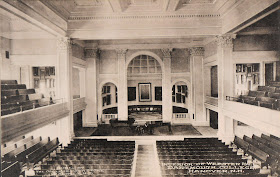What's with the stained blank page? If you could feel it, you would also ask why it feels so odd. It has a kind of waxy coating, feels a little like vellum, but not as supple, and it has streaks of old ink set into its scratched surface.
We often value our old books for the extensive marginalia left behind by generations of readers. The comments give us insights into how the text was received in other times and places. But not all readers wanted to fill their books with notations.
This copy of the Elsevier 1665 edition of Boccaccio's Decameron was highly portable, but the compact size left little room in the margins for notes. The solution was ingenious. At the front and back are two leaves very different from the rest of the paper in the book. These are erasable surfaces, where a reader could jot down notes as he or she read. The reader could then transcribe the notes into a commonplace book and, with a damp rag, rub away the comments. The book stays clean, the notes are captured, and there is space for further musings.
The staining shows at least one reader was actively using the erasable pages to record thoughts, what they were, we will never know.
Ask for Presses E52bo.
Friday, May 17, 2013
Tuesday, May 14, 2013
Postcards from the Green
 The first postcard ever sent was in Austria in 1869, but it took a few years for the trend to catch on in the United States. The U.S. Post Office issued its first postcard in 1873. However, it was not until 1907, when postcards were allowed the divided back for a message and the address on one side and a full picture on the other, that postcards hit their "Golden Age." As photographic technology improved, postcards gained the ability to showcase the daily lives of the senders. At Dartmouth, postcards have been used throughout the years to promote the college, give family back home and idea of what is happening, or simply to let someone know they are missed. Looking at Dartmouth postcards over time shows how much has changed in Hanover in the last century - and what has stayed the same.
The first postcard ever sent was in Austria in 1869, but it took a few years for the trend to catch on in the United States. The U.S. Post Office issued its first postcard in 1873. However, it was not until 1907, when postcards were allowed the divided back for a message and the address on one side and a full picture on the other, that postcards hit their "Golden Age." As photographic technology improved, postcards gained the ability to showcase the daily lives of the senders. At Dartmouth, postcards have been used throughout the years to promote the college, give family back home and idea of what is happening, or simply to let someone know they are missed. Looking at Dartmouth postcards over time shows how much has changed in Hanover in the last century - and what has stayed the same.


 Perhaps the most revealing postcard in terms of changes at Dartmouth is not a photograph, but instead a miniature poster from 1916. Nate, the author and a member of the class of 1920, wrote his father "This is a miniature of the poster that all Freshmen must buy." The poster addresses, "Ye Puny Prodigals of Prep-school, Ye Pups of Ignorance, Ye Illiterate Imbeciles:" in other words, the freshman class. The class of 1919 lays forth twelve rules for the class of 1920 to follow, including the need to wear a "cute green cap with a monstrous white button" and to "never short-cut across the grass." While the college no longer allows such hazing of freshmen, Nate's writing on the postcard is similar to that of a quick e-mail home. He requests curtains for his dorm room windows, asks how everything is at home and of course tells his father of all the work he has to get done before his vacation Friday. Check out Dartmouth's postcard collection to see the evolution of other aspects of Dartmouth, from fraternity houses to Winter Carnival, in 3 1/2 by 5-inch tidbits.
Perhaps the most revealing postcard in terms of changes at Dartmouth is not a photograph, but instead a miniature poster from 1916. Nate, the author and a member of the class of 1920, wrote his father "This is a miniature of the poster that all Freshmen must buy." The poster addresses, "Ye Puny Prodigals of Prep-school, Ye Pups of Ignorance, Ye Illiterate Imbeciles:" in other words, the freshman class. The class of 1919 lays forth twelve rules for the class of 1920 to follow, including the need to wear a "cute green cap with a monstrous white button" and to "never short-cut across the grass." While the college no longer allows such hazing of freshmen, Nate's writing on the postcard is similar to that of a quick e-mail home. He requests curtains for his dorm room windows, asks how everything is at home and of course tells his father of all the work he has to get done before his vacation Friday. Check out Dartmouth's postcard collection to see the evolution of other aspects of Dartmouth, from fraternity houses to Winter Carnival, in 3 1/2 by 5-inch tidbits.Ask for Rauner Iconography 1523 to see all 1400 plus postcards.
Posted for Kate Taylor '13


